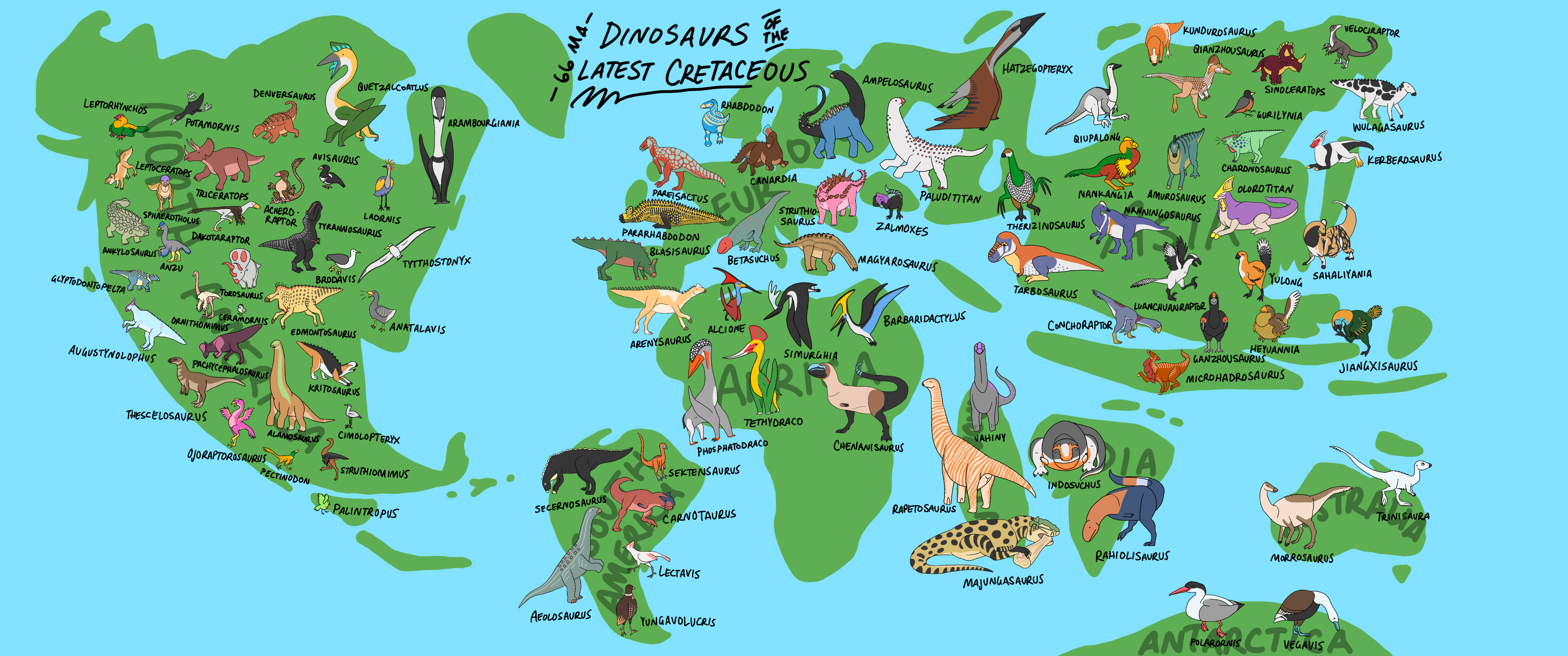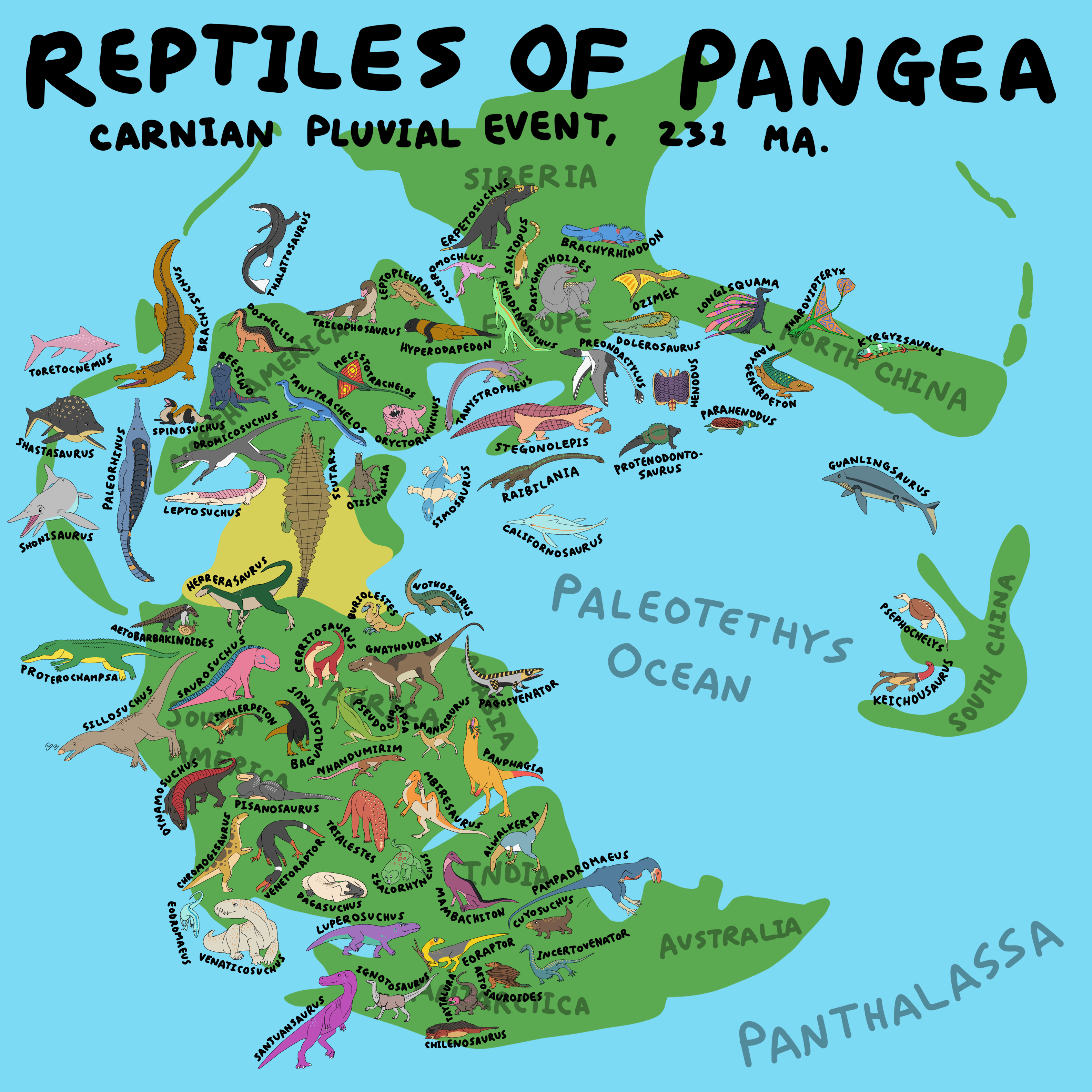While it’s hard to argue that any geologic period other than the Cretaceous (145-66 million years ago) is the best one, for me, the Triassic (252-201 million years ago) comes in a very close second place. Bordered by two of the Big Five mass extinctions, it was a period of recovery and rapid diversification. Many of the lineages that appeared didn’t make it through the Triassic-Jurassic extinction at the end of the period, so there are many animal groups that are unique to the Triassic, never seen before or since. I’ve written about some of the early dinosaurs from this period in another post.
The Triassic is divided into Early, Middle, and Late epochs, but the Early and Middle Triassic lasted only five to ten million years each, while the Late Triassic spans 36 million years. Some weird animal forms like the hammer-mouthed Atopodentatus and the pelican-throated Hupehsuchus, both marine reptiles, lived and died during the Early and Middle Triassic, but most of the fun critters I want to write about hail from the Carnian Pluvial Episode, a period of climate change and increased precipitation at the very beginning of the Late Triassic that jump-started dinosaur evolution.
The supercontinent Pangea (“all-earth”) formed at the end of the Carboniferous Period and broke in half at the end of the Triassic, meaning that only the earliest dinosaurs could’ve walked from pole to pole. The continent was roughly C-shaped, with an enormous bay in the middle called the Paleotethys Ocean, and the rest of the seas around the outside known as Panthalassa (“all-sea”). The seasonal heating and cooling of the northern and southern halves of the Paleotethys would have resulted in a global mega-monsoon climate pattern each year, and a huge, near-uncrossable desert at the belt of the C, segregating the faunas of the two hemispheres.
Note that this map only includes reptiles, and one reptiliomorph. There were lots of early mammal relatives like cynodonts and dicynodonts and large temnospondyl amphibians that were important and widespread at the time. But I already drew eighty-one reptiles and felt like that was enough.
Laurasian (Northern) Fauna
At this time, the northern continents, collectively known as Laurasia and including modern-day North America, Europe, and Asia sans India, were completely dinosaur-free, while the southern continents were swarming with early dinos! Instead, a diverse array of early croc relatives, basal archosaurs, and marine reptiles filled the available niches.
Allokotosaurs
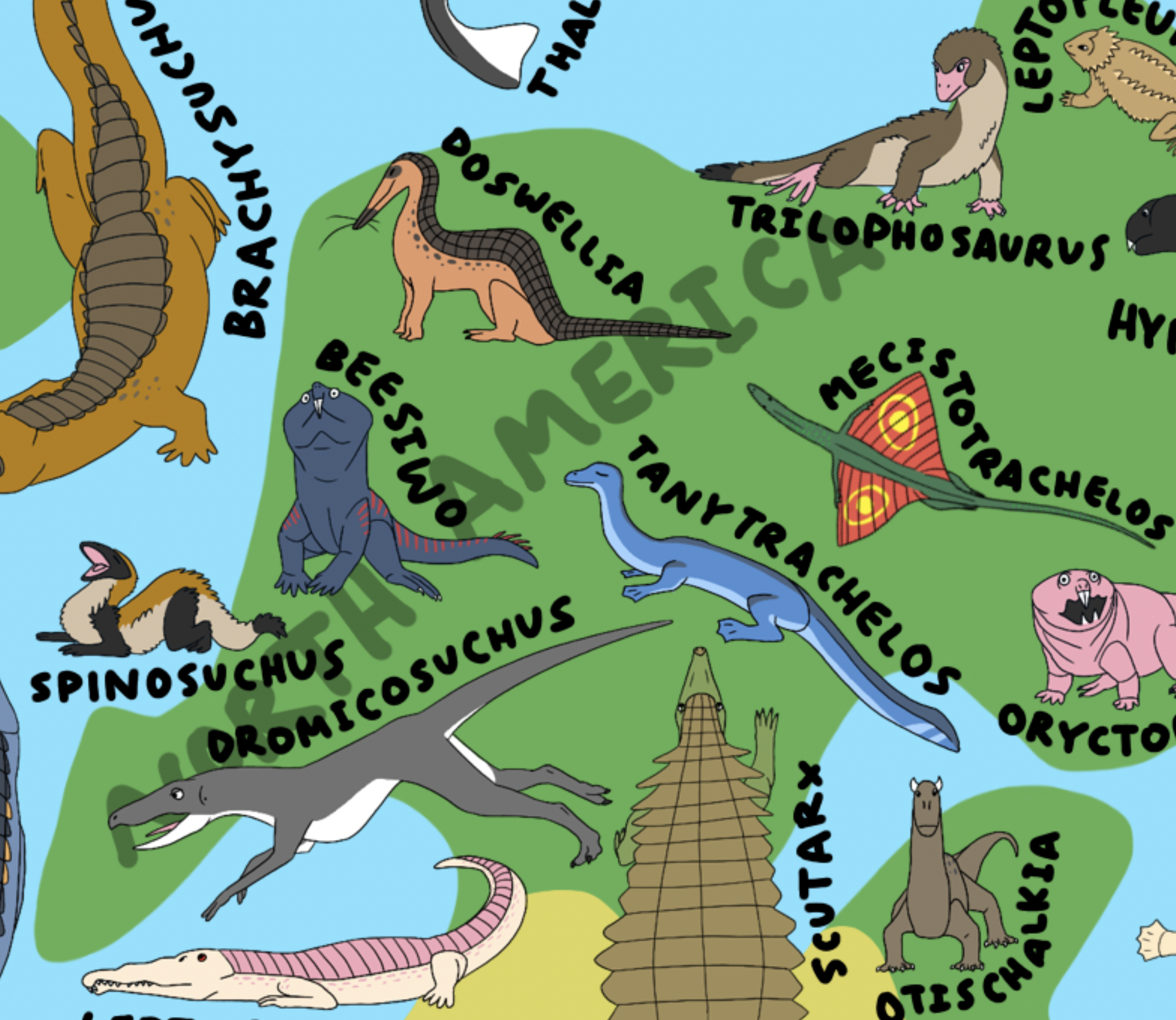
Trilophosaurus, Spinosuchus, and Otischalkia
Based on bone histology, we can tell that these vaguely iguana-shaped basal archosauromorphs were probably warm-blooded, and therefore likely fluffy! Based on that, I drew them as sort of fluffy iguana-ferrets. Otischalkia is only known from fragmentary remains, so I chose to draw it as similar to the charismatic horned Shringasaurus, which hails from the Middle Triassic.
Sharovipterygids
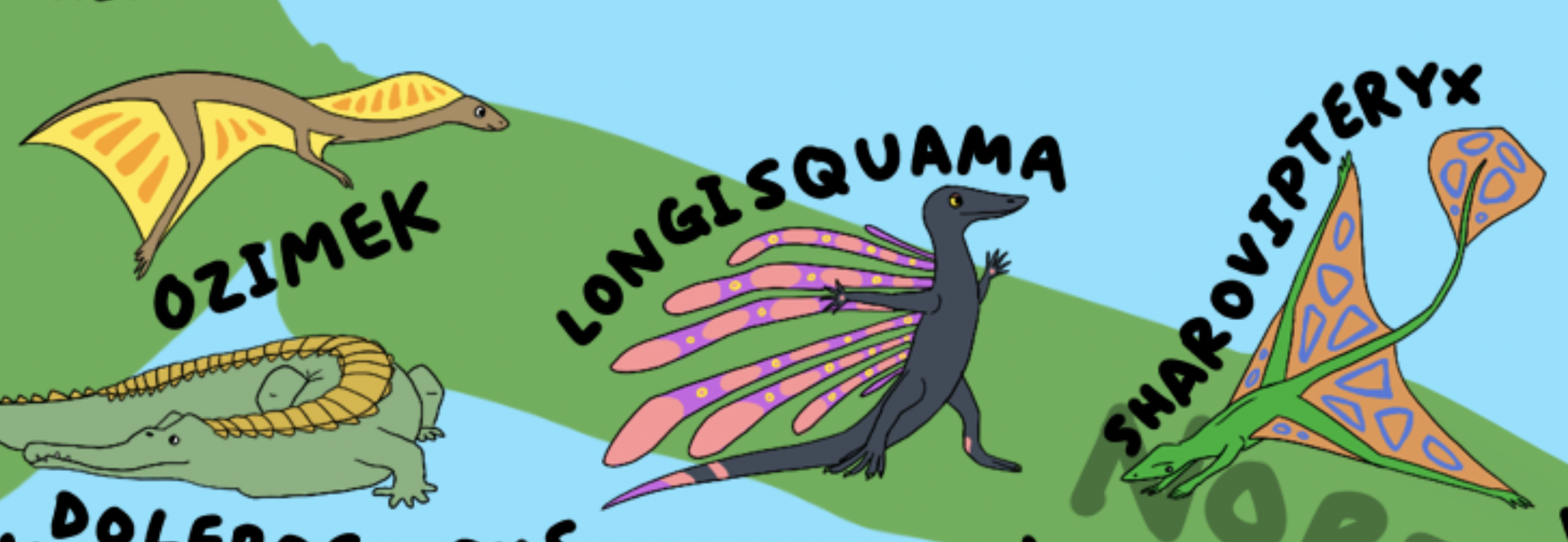
Sharovipteryx, Ozimek, and maybe Longisquama
Since all flying vertebrates today use their forelimbs as wings, it seems counterintuitive that hindlimbs could even work, aerodynamically. But the sharovipterygids, another type of basal archosaur, did exactly that. They were probably not capable of powered flight, but would have glided using membranes of skin. Like most gliding vertebrates today, they hail from Asia. What is it about the Eastern Hemisphere that encourages gliding?
Longisquama is possibly a member of this group that didn’t glide, but had hockey-stick-shaped skin flaps on its back for decoration.
Tanystropheids
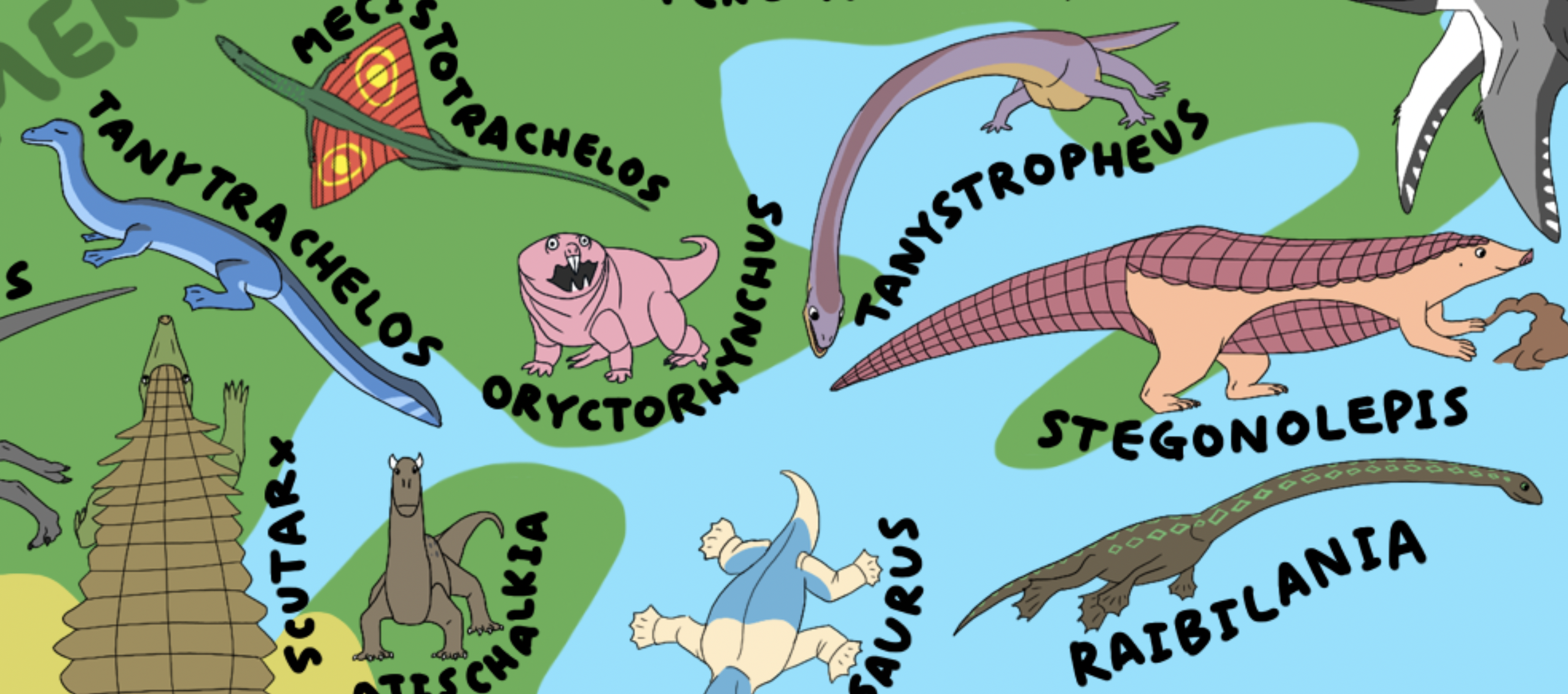
Raibliania, Tanystropheus, and Tanytrachelos
Another basal archosaur group, the tanystropheids were like living fishing poles, with long, stiff, lightweight necks they probably used for catching fish while standing on the shore. While Tanytrachelos was less than a foot long (20 cm), some specimens of Tanystropheus would have been a couple feet tall, but twenty feet long (6 m)! Some paleontologists theorize that they would have caught prey while swimming, so I’ve depicted both styles here.
Phytosaurs
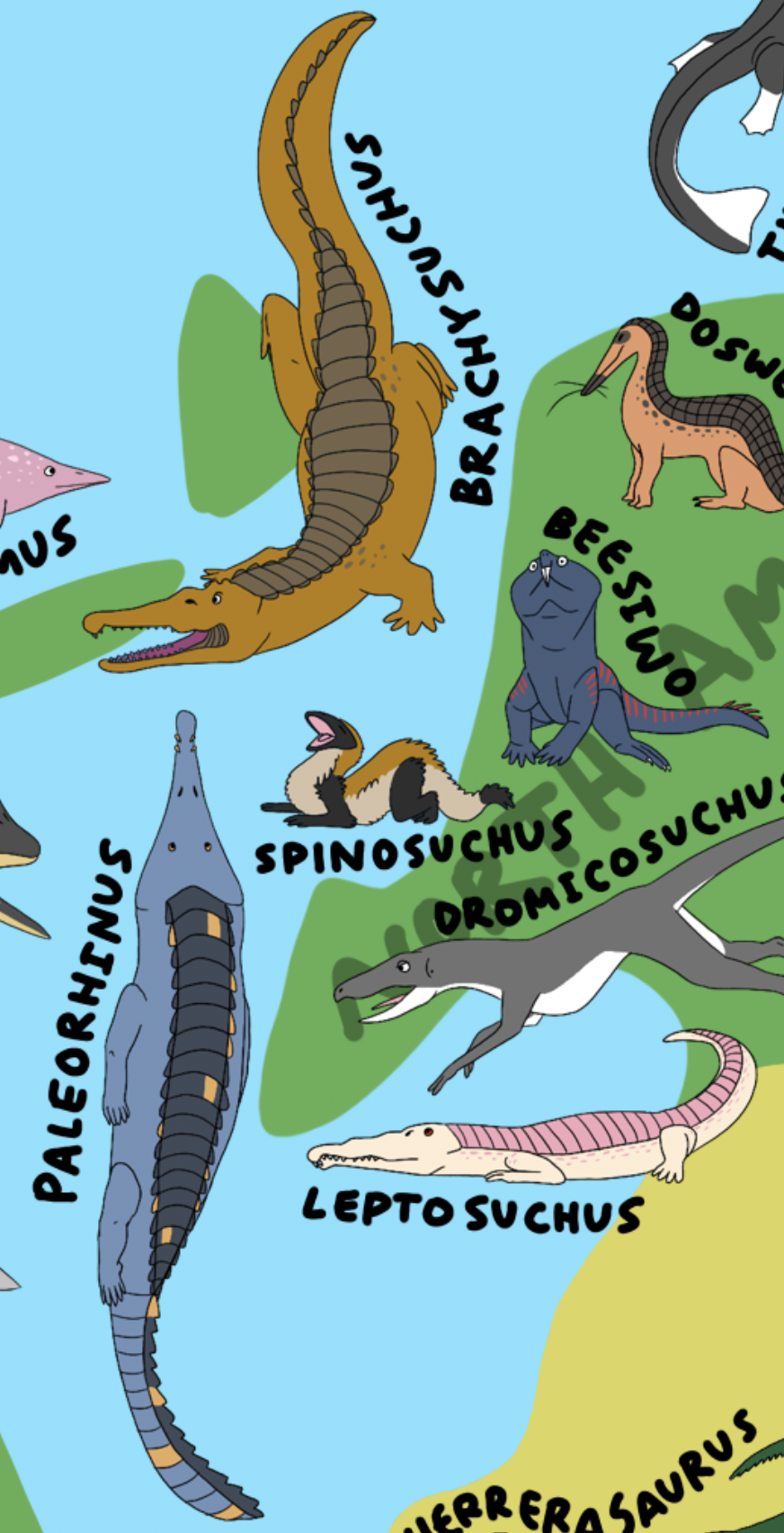
Brachysuchus, Paleorhinus, Leptosuchus, and maybe Dolerosaurus
While these guys look like crocodiles, they are actually another group of basal archosaurs that convergently arrived at many of the same adaptations as true crocodiles. Pro tip: you can tell it’s a phytosaur if its nostrils are up near the eyes; crocs have theirs on the tip of the snout. Confusingly, “phytosaur” means “plant reptile”, because early fossils were thought to belong to herbivores of some kind.
Ichthyosaurs
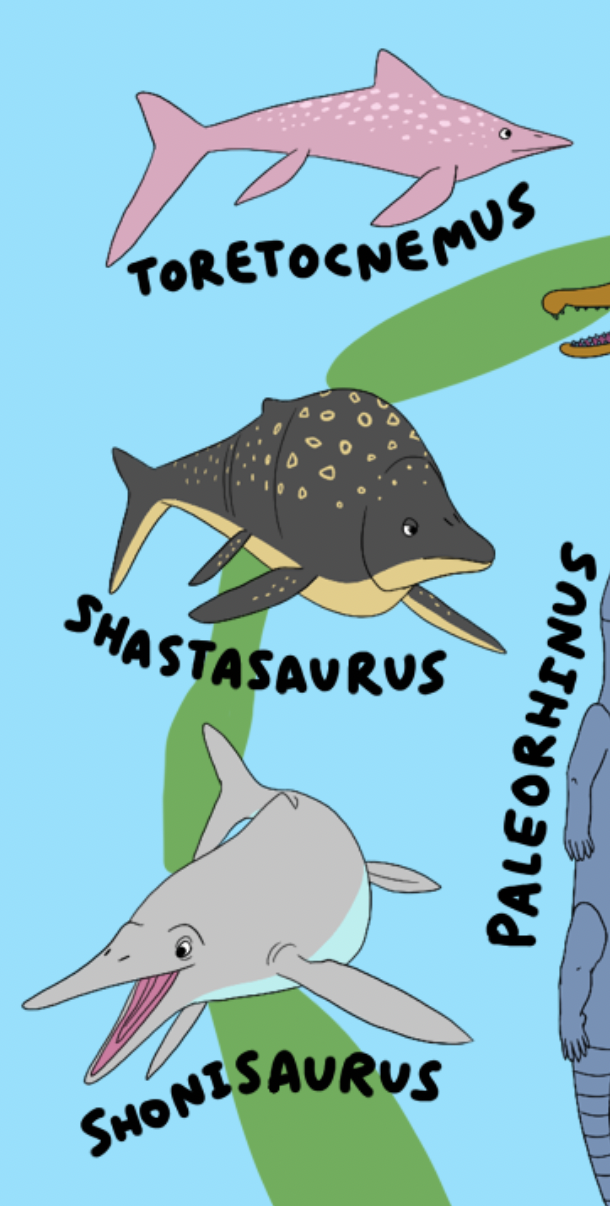
Shastasaurus, Californosaurus, Shonisaurus, Toretocnemus, and Guanlingsaurus
Ichthyosaurs (“fish reptiles”) rose to world domination very quickly after the Great Dying, achieving whale-like body sizes within single-digit millions of years. Shastasaurus and Shonisaurus were particularly huge, rivaling fin whales (but not blue whales!) at an estimated eighty tonnes. Unlike either large baleen or toothed whales, these early giant ichthyosaurs had small heads with long, toothless snouts, indicating that they fed differently than modern oceanic giants. The leading hypothesis is that they suctioned up soft-bodied prey like squid or jellyfish.
Placodonts
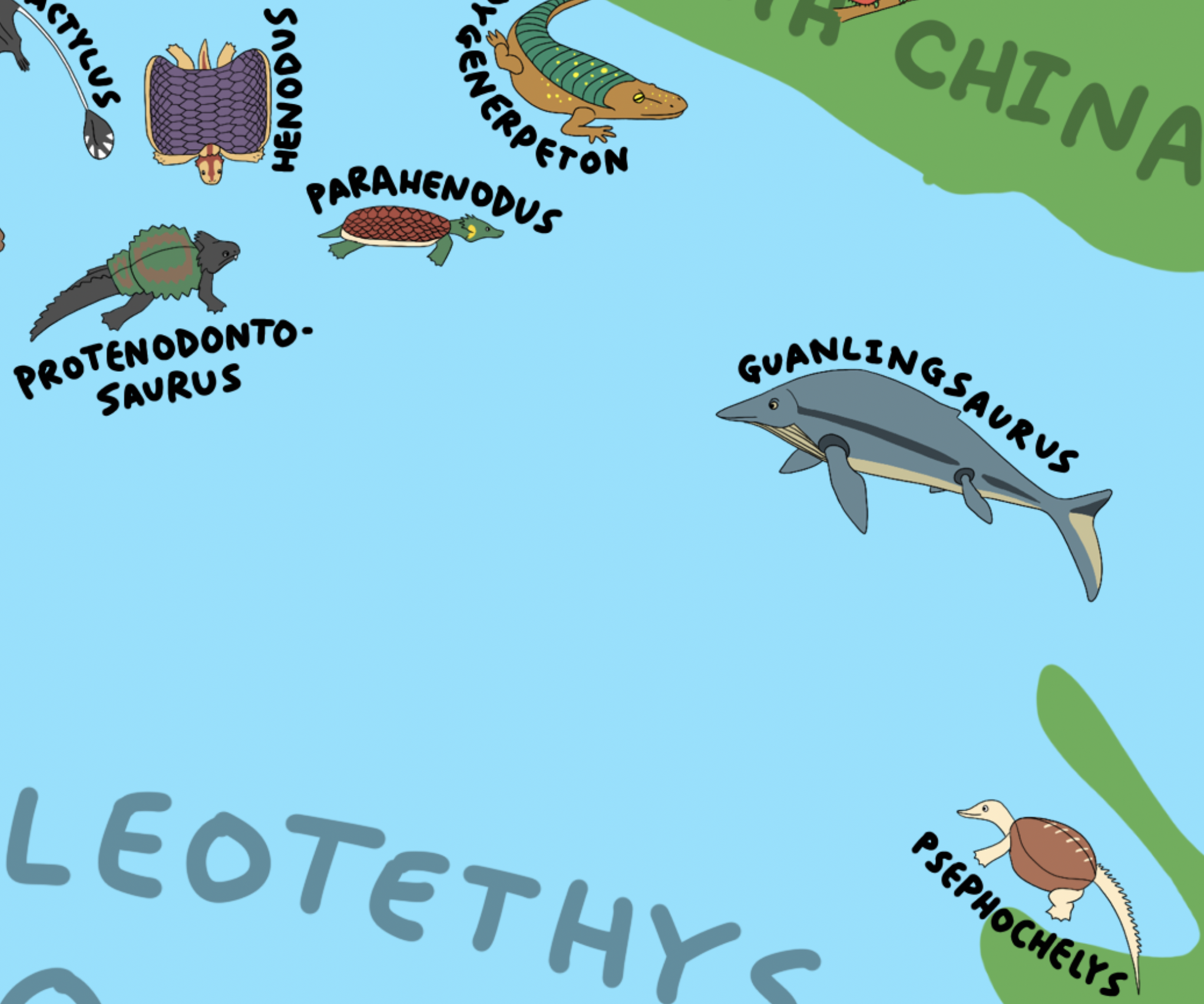
Psephochelys, Henodus, Parahenodus, and Protenodontosaurus
Not to be confused with the Devonian armored fish known as placoderms (meaning “plate skin”) such as Dunkleosteus, placodonts (“plate teeth”) were a group of turtle-like relatives of plesiosaurs (Nessie-like aquatic reptiles) that were completely unrelated to turtles. They had many stranger shell geometries than modern turtles, and had flat teeth for crushing the shells of their prey.
Pterosauromorphs
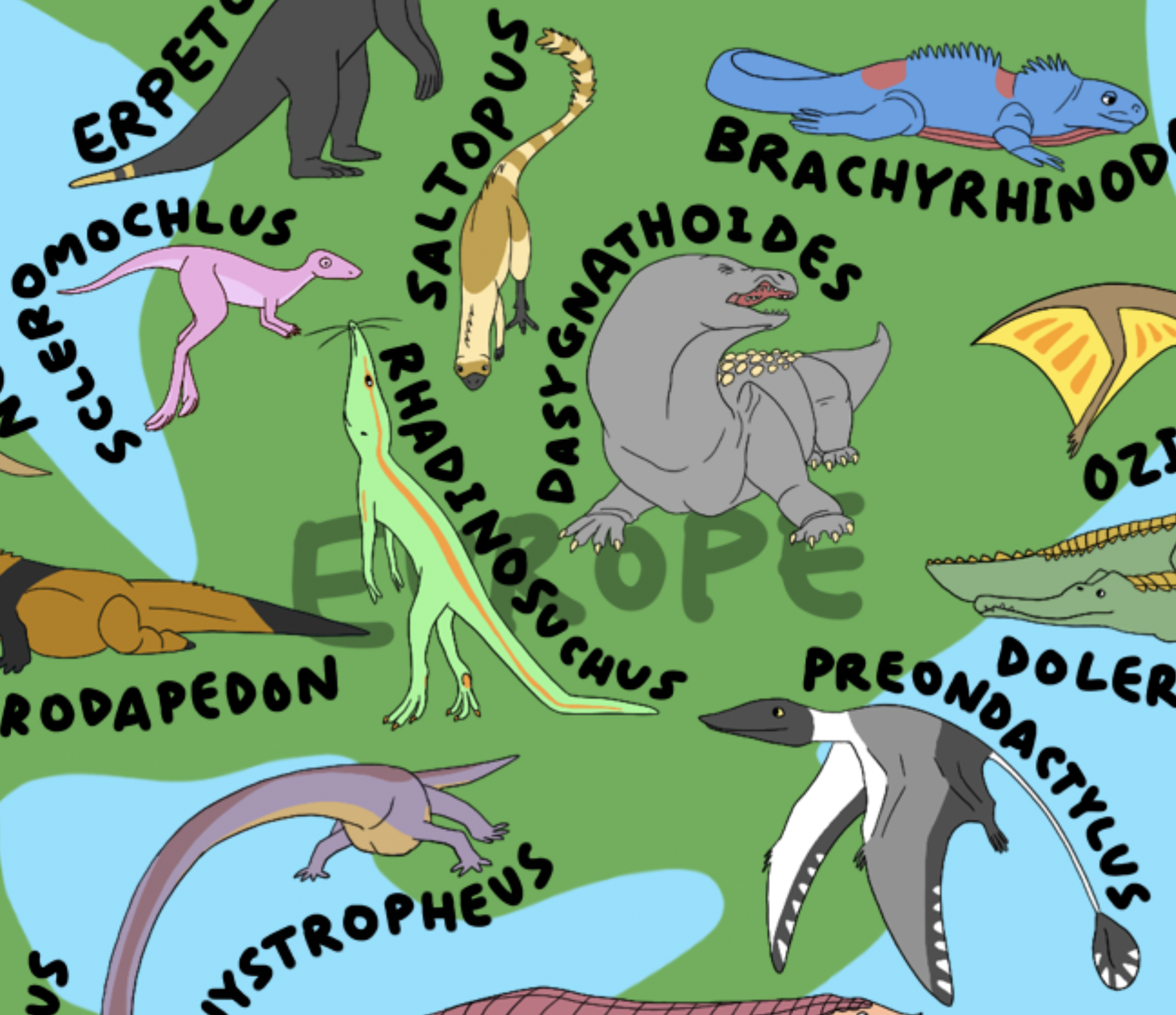
Preondactylus and Scleromochlus
Like Athena from Zeus’s cranium, pterosaurs sprung fully-formed into the fossil record with no known transitional gliding or small-winged forms. Preondactylus was one of the very first to appear in the fossil record; many more genera appeared later in the Triassic and spread across Europe and North America. Scleromochlus was a small hopping desert-dweller like a jerboa that couldn’t fly, but features of its skeleton indicate that it was a close relative of pterosaurs.
What is Saltopus? We don’t know for sure. The very base of the dinosaur family tree is under constant taxonomic revision, with families close to true dinosaurs like lagerpetids, silesaurids, and aphanosaurs shuffling around a lot based on new finds and reanalysis of existing material using new methods. I would venture a guess that it will shake out to be closer to pterosaurs than dinosaurs, simply because of its geographic location.
Gondwanan (Southern) Fauna
Dinosauriformes
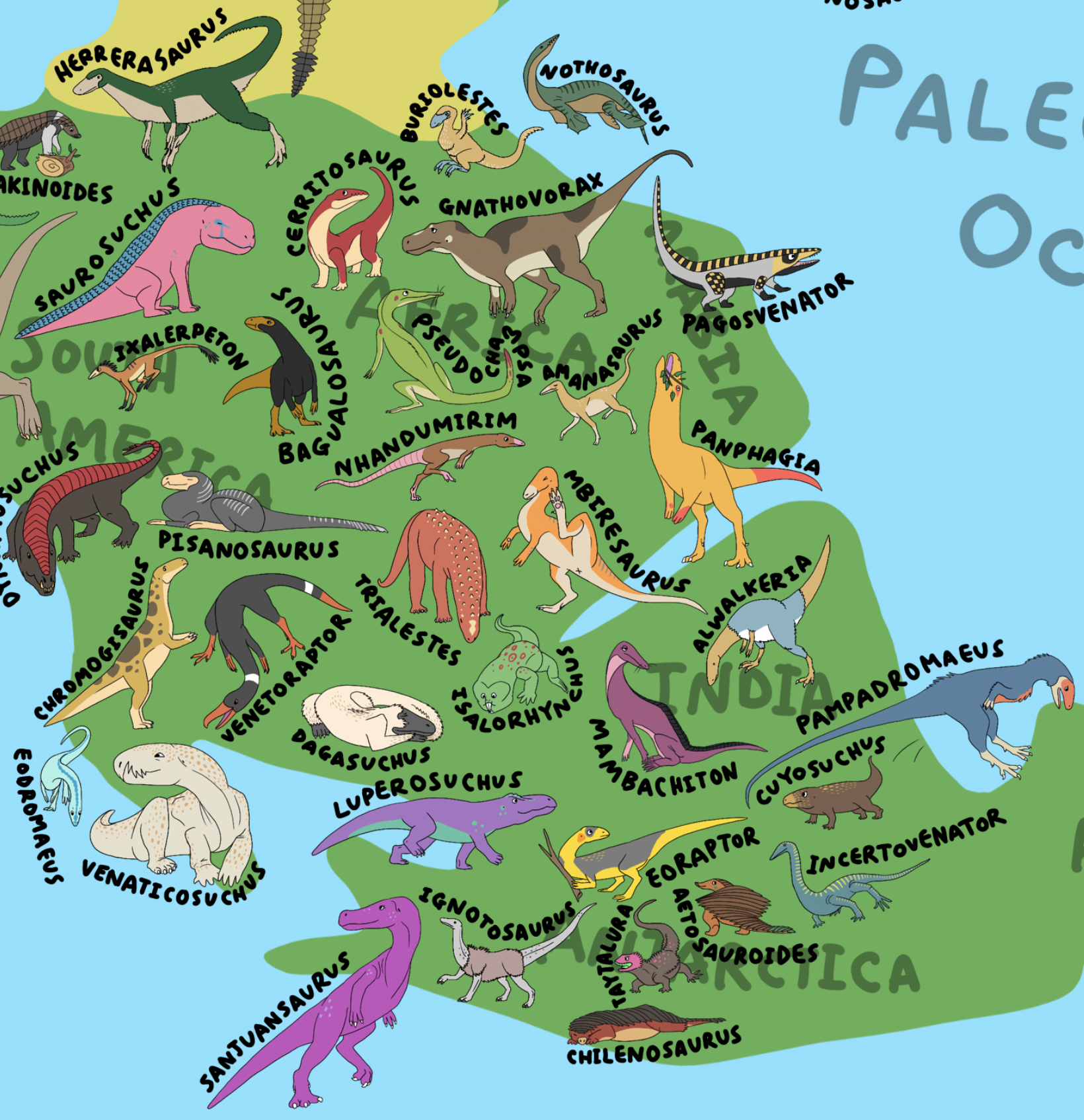
Look at all these bipedal, mostly undifferentiated dinosaurs crowding the southern continents! Even at their very beginning, dinosaurs seemed to be on the rise, producing a variety of small and large carnivores as well as omnivores and possibly some herbivores. Poised on the cusp of world domination, the only thing stopping them was that pesky desert. If only someone would do something about that…
Herrerrasaurids
Gnathovorax, Herrerasaurus, and Sanjuansaurus
These very generic theropod-looking dinosaurs were probably not that closely related to theropods, instead being a separate lineage that left no descendants. They were coyote to bear-sized carnivores at around two to five meters in length, faster and lighter-built than their croc-line competitors.
Sauropodomorphs
Panphagia, Chromogisaurus, Bagualosaurus, Buriolestes, Alwalkeria, Eoraptor, Pampadromaeus, Mbiresaurus, and Nhandumirim
Representing the bulk of the dinosaur genera, these early relatives of the later giant herbivorous long-necked dinosaurs known as sauropods were mostly omnivores and small carnivores. At this point in time, there weren’t any reptilian macroherbivores; that niche was filled at the time by the elephant-like dicynodonts (mammal relatives) and armored crocodylian aëtosaurs (more on them later). These early sauropodomorphs’ bones weren’t yet hollow, while their later descendants’ bones were, indicating that hollow bones was not the ancestral condition and that each dinosaur and pterosaur group evolved their complex system of respiratory air sacs independently.
Ornithoscelidans
Pisanosaurus and Eodromaeus
Ornithischians, the group of herbivorous dinosaurs that would later include Triceratops, Pachycephalosaurus, Stegosaurus, and others, arose later than the saurischian line, which was already full of sauropodomorphs and herrerasaurids by this time. Pisanosaurus, a rabbit-sized herbivore, is the earliest ornithischian known. Eodromaeus was an early true theropod, which some modern studies place as more closely related to ornithischians than to herrerasaurs.
Lagerpetids
Ixalerpeton and Venetoraptor
Very closely related to dinosaurs but not true dinosaurs, lagerpetids (meaning “rabbit creeper”) were small, warm-blooded insectivores. Some research places Scleromochlus in this group too, and positions the whole lagerpetid group closer to pterosaurs than dinosaurs, but neither hypothesis is clearly winning as of now. It’s also unknown whether they were quadrupedal or bipedal, so I’ve depicted one of each. Here’s to hoping we find more fossils of these little guys soon.
Silesaurids
Ignotosaurus and Amanasaurus
Also not true dinosaurs, silesaurids were gracile, quadrupedal herbivores. Both of these genera are known from only very fragmentary remains, so it’s hard to say exactly how big they were or what they would’ve looked like. My depictions give them generic silesaurid-ish traits.
“Prestosuchids”
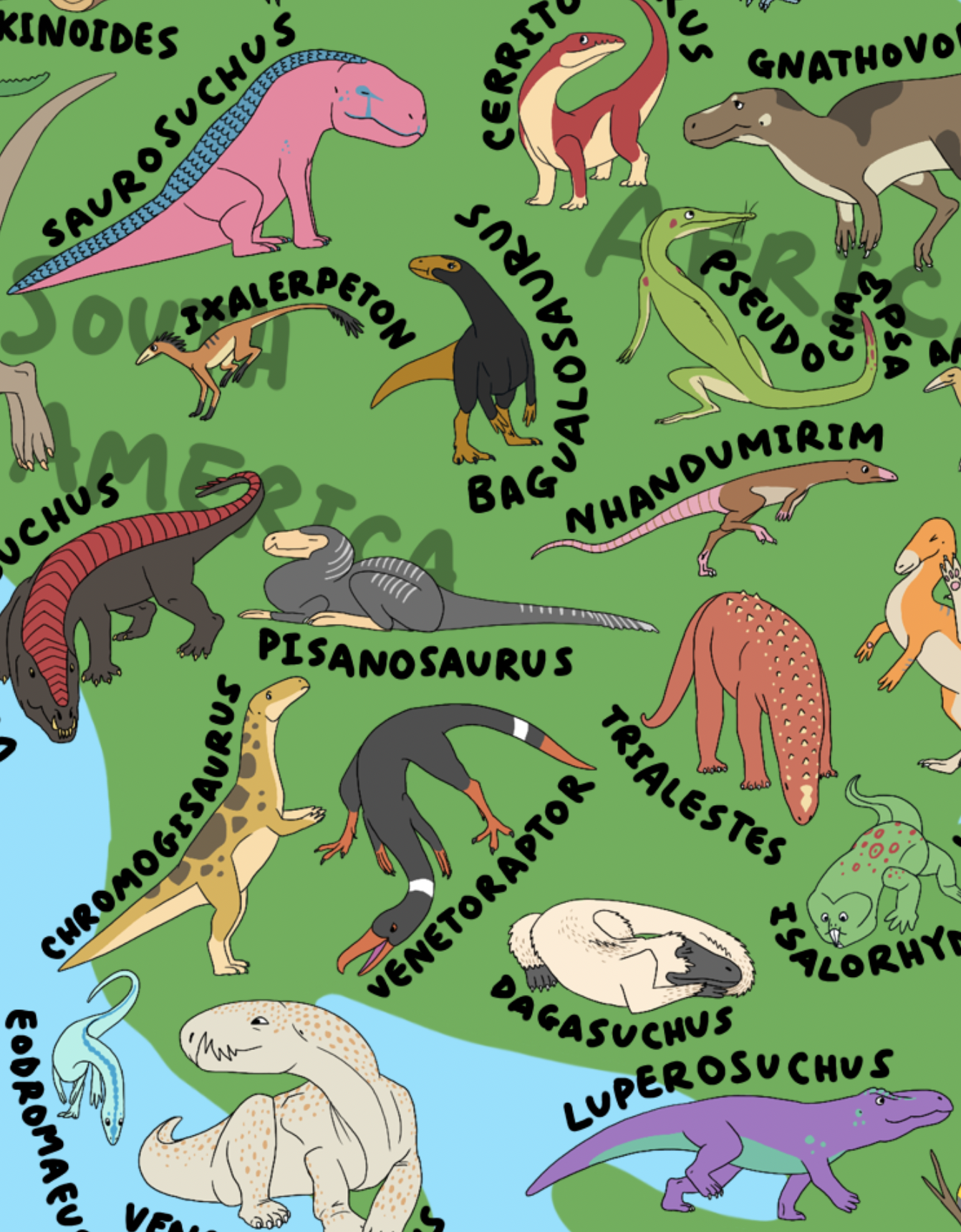
Dagasuchus, Saurosuchus, and Luperosuchus
These large, impressive, warm-blooded land-crocs would have been fearsome to encounter, and would have been the largest predators in their environment. The name “prestosuchids” is in quotes because it’s polyphyletic, representing a transitional “grade” between the more basal ornithosuchids and more derived rauisuchids rather than a true clade. How I wish we had terrestrial reptilian macropredators today! What a sad world that lacks them!
Ornithosuchids
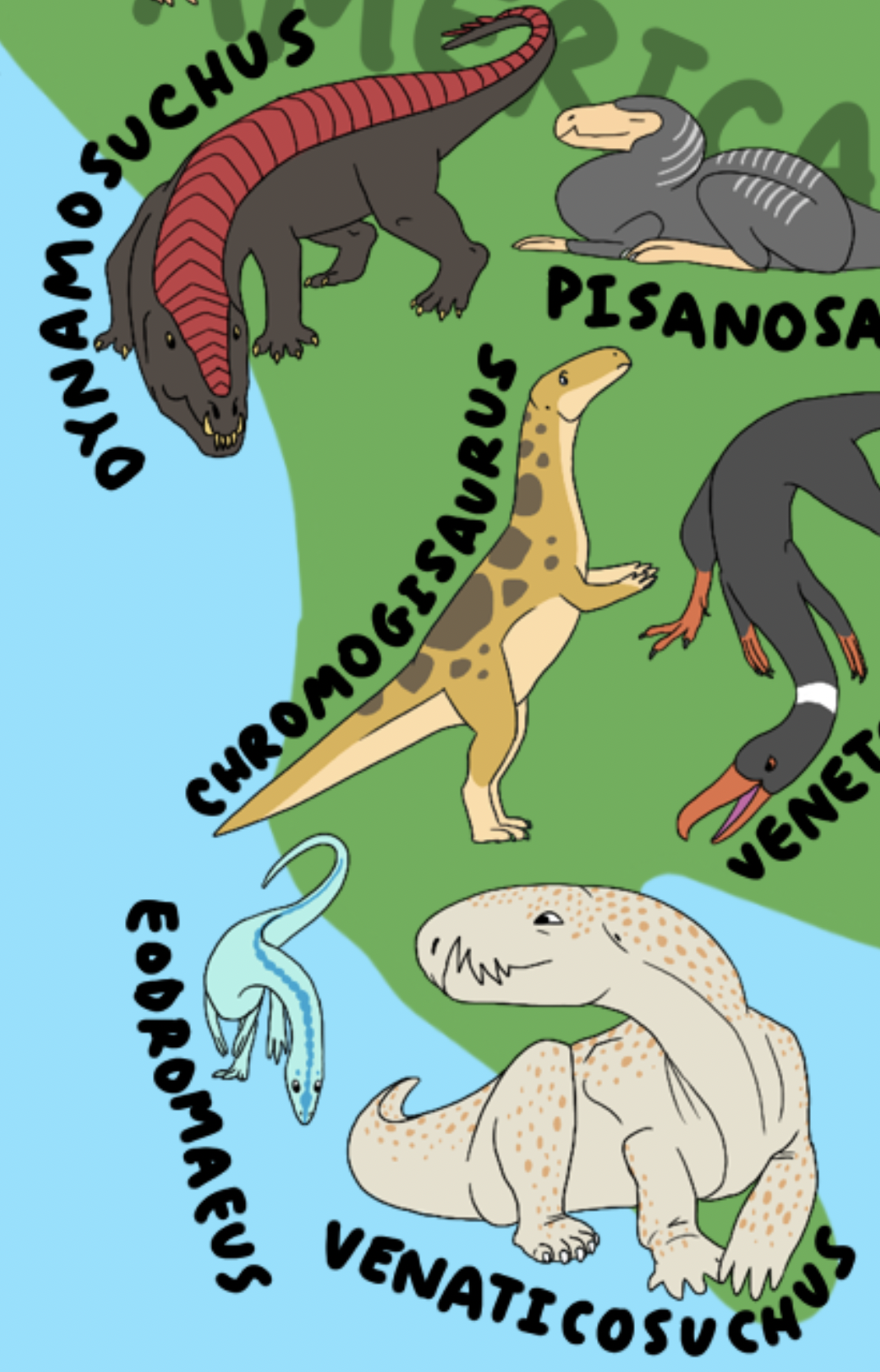
Dynamosuchus and Venaticosuchus
Only four genera are described from the ornithosuchids, so this represents fully half of their known diversity! These land-crocs were a bit more primitive and a bit more bipedal-capable than the “prestosuchids”, and had funky overlapping teeth in the front.
Globetrotters (Both Hemispheres)
Proterochampsids
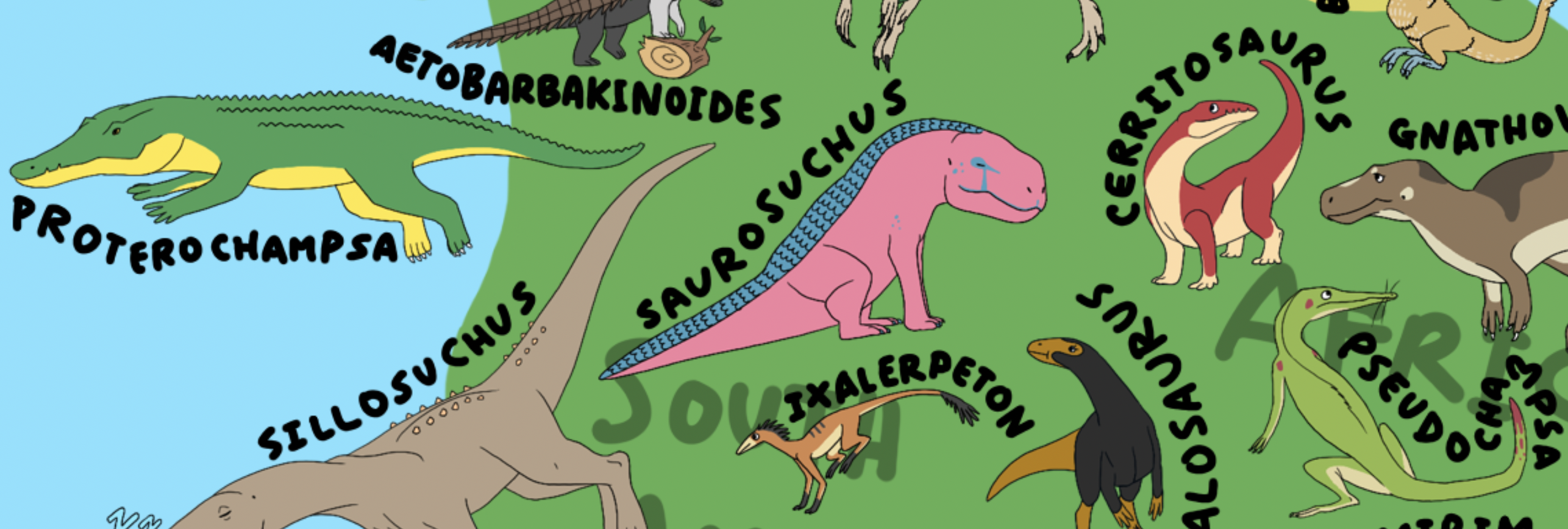
Proterochampsa, Pseudochampsa, Rhadinosuchus, Doswellia, and Cerritosaurus
Meaning “former crocs”, these small basal archosauriformes were diverse and globally distributed during the Carnian, covering a variety of sizes, builds, snout lengths, and levels of armor. I’ve drawn them kind of eclectically here, with Doswellia, Pseudochampsa, and Rhadinosuchus very warm-blooded and mammaly-looking while Cerritosaurus and Proterochampsa are more reptilian. It’s kind of fun being able to speculate (within scientific bounds, of course!).
Erpetosuchids

Pagosvenator and Erpetosuchus
These were another group of quadrupedal croc-line terrestrial predators. It’s not confirmed whether Pagosvenator actually belongs to this family or with the ornithosuchids or somewhere else. But other genera confidently assigned to erpetosuchids is known from the southern continents (Parringtonia from Tanzania), so we do know that this family did somehow cross the desert. I’ve drawn Erpetosuchus as kind of bear-like and Pagosvenator as badger-like, not for any real reason other than their body shapes sort of reminded me of those animals.
Aëtosaurs
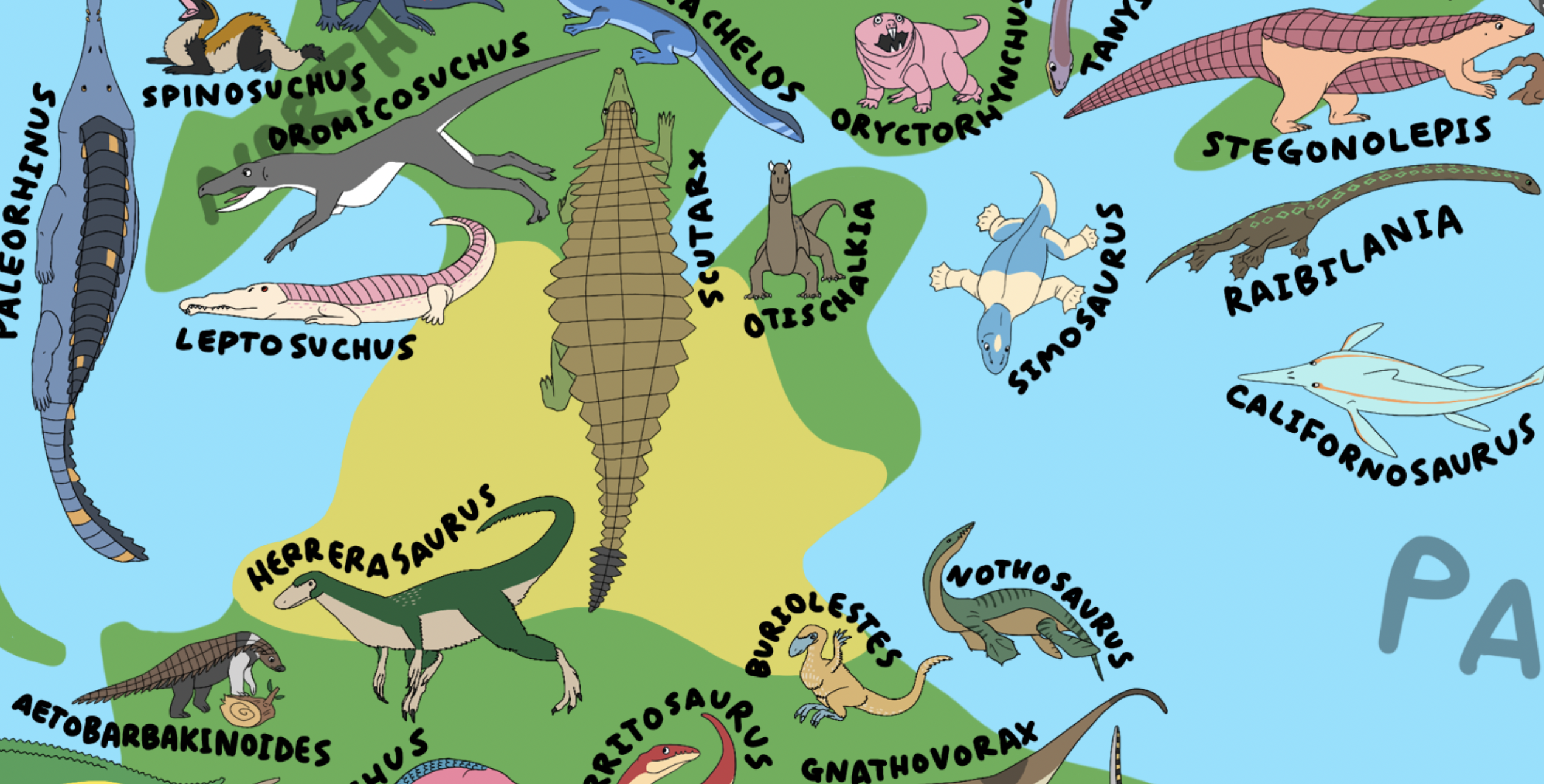
Aetosauroides, Scutarx, Chilenosaurus, Aetobarbakinoides, and Stegonolepis
Unlike the above two groups, it’s obvious to me how an aëtosaur (“eagle reptile”) could have crossed the uncrossable desert. These herbivorous, pig-snouted crocs were big and heavily-armored, the first iteration of the “tank herbivore” body design that would later be replicated by ankylosaurs and then glyptodonts. While a big pig is the obvious comparison, these animals also remind me in some ways of the giant anteater, which I based Aetobarbakinoides’s depiction on. What a terrible name for a genus. Whoever named it should get a stern talking-to.
Side note, when an umlaut is added to a vowel for the purposes of showing that it should be pronounced/emphasized separately from the previous vowel, it’s called a diaeresis. So this group name should be pronounced “ay-EE-to-saurs” rather than “AY-to-saurs”. This is why you sometimes see “naïve” or “coöperate” spelled that way, and why some Zoës and Chloës employ diaereses. Other examples: the Greek mythical figure Pasiphaë and the French woman’s name Anaïs.
Rhynchosaurs
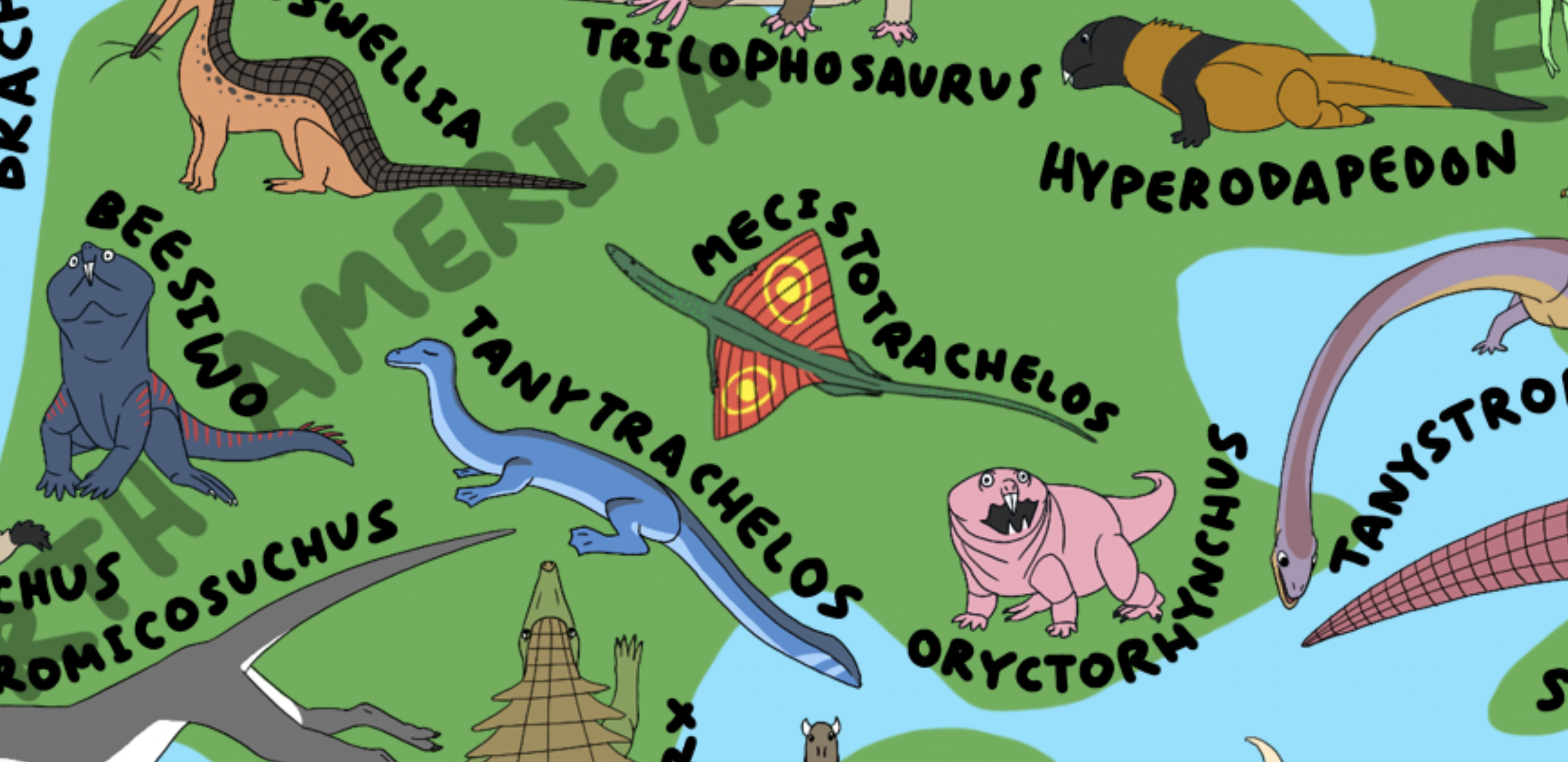
Oryctorhynchus, Beesiwo, Hyperodapedon, and Isalorhynchus
Similar to the aëtosaurs, it’s easy to imagine these hardy little herbivores trekking through a hostile desert. Often confused with rhynchocephalians (tuatara relatives), rhynchosaurs (“snout reptile”) were small, stocky animals with powerful jaw muscles for snipping and grinding tough vegetation. Unusually for a reptile, they had a fixed number of teeth that could erupt during their lifetimes, and like elephants would have starved to death if they survived long enough to run out.
Nothosauroids
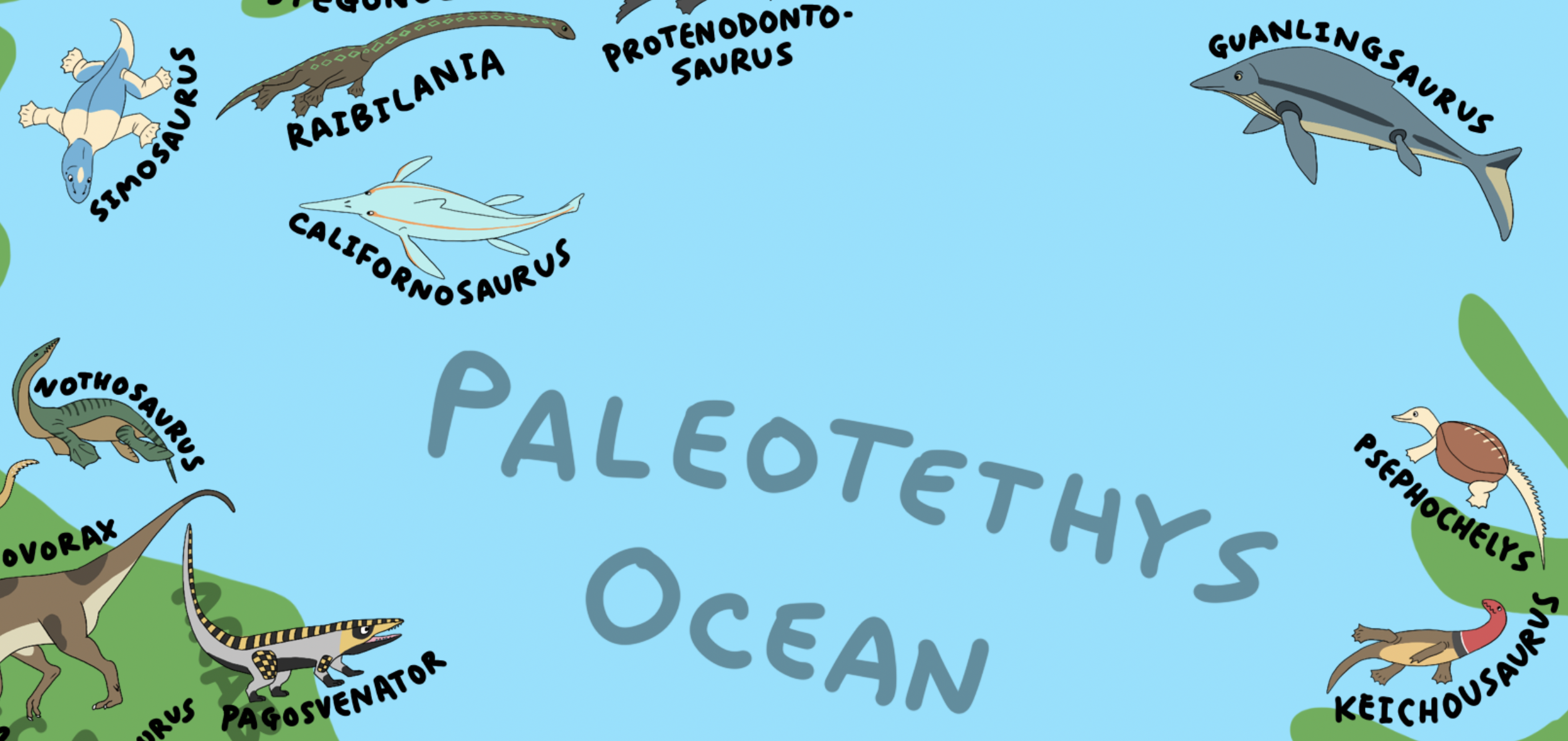
Keichousaurus, Simosaurus, and Nothosaurus
While ichthyosaurs assumed their final form very rapidly following the Great Dying, plesiosaurs (Nessie-like marine reptiles) took awhile to get to full aquatic mode. Nothosaurs were a transitional form between terrestrial reptiles and plesiosaurs that were a diverse and successful clade in their own right. Nothosaurus could get big, at up to 7 meters (23 feet), while Keichousaurus was tiny at only 12cm (5 inches)! Simosaurus was in between at 3 or 4 meters in length, and was notable for its barrel chest and blunt, shell-crushing teeth. Nothosaurs probably hauled out of the water to bask and breed like modern seals, something later plesiosaurs would lose the ability to do.
One-offs
Here are some families for which only one representative is known from this time period.
Sillosuchus was a shuvosaurid, a type of advanced crocodylian trying its hardest to be a dinosaur. The most famous shuvosaurid is Effigia from Ghost Ranch, which was doing such a convincing dinosaur impression that it was overlooked among the Coelophysis skeletons for over fifty years!
Thalattosaurus was a thalattosaur, a type of marine reptile that rose and fell within the Triassic. It had both sharp and blunt teeth, indicating that it could crush shells as well as maybe snag small fish.
Kyrgyzsaurus was an early drepanosaur, a type of chameleon-like reptile that became more diverse and widespread later in the Triassic.
Brachyrhinodon was a sphenodontian, a relative of modern tuatara, and like tuatara would have been a cold-blooded herbivore.
Uncertain Affinities
The further back in time you go, the more fragmentary the fossil remains become. There are many animals I’ve depicted that can’t be confidently assigned to a particular family, and I just chose one and ran with it in their depictions.
Crocs of some kind: Dasygnathoides, Trialestes, and Dromicosuchus can’t be assigned to any particular croc family. Cuyosuchus might be a small, late-surviving erythrosuchid, a lineage of early reptiles with small bodies and gigantic predatory heads, but it can’t be confidently assigned to any family.
Basal archosaurs: Mambachiton, Mecistotrachelos (another one with gliding adaptations, but using rib-wings like modern Draco lizards), Incertovenator
Others: Taytalura was a basal lepidosaur (relative of lizards, snakes, and tuatara, but not in any of those groups); Leptopleuron was a parareptile, a member of a very basal lineage that split off before lizards diverged from birds; and Madygenerpeton was a reptiliomorph, an amphibian-like animal more closely related to reptiles than to amphibians.
Note
This is my second comprehensive genus map; I did another one in February of 2020 covering all the ornithodires (dinosaurs and pterosaurs) that lived at the end of the Cretaceous, the other time period with the coolest fauna. You can see that my animal doodling skills have greatly improved since then! Right after finishing this one, I started the Triassic one, but ran out of steam after finding that all nine sauropodomorphs looked the same to me. I picked the project back up over four years later. I did use a couple of the preliminary doodles from 2020 for the Triassic map–see if you can pick out which ones they are!
